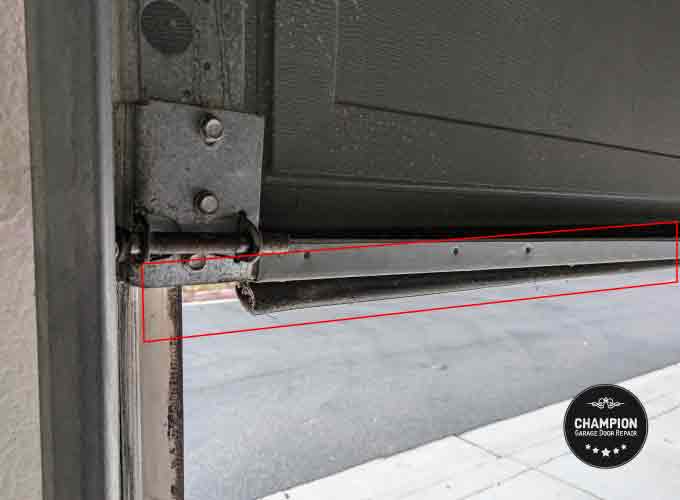As the cold months approach, you may want to take a moment ensure your garage door is prepared for winter. Proper preparation and maintenance not only protect your garage and door from rainfall and potential water damage but also improves energy efficiency, saves on future repair costs, and keeps your garage functioning smoothly throughout the winter.
Here are seven expert tips for winter maintenance to help get your garage door ready for the cold and rainy season.
1. Inspect and Lubricate Moving Parts
Start by inspecting all the moving parts of your garage door, including the hinges, rollers, and bearings. Look for cracks, rust, excessive looseness, and overall wear. Cold weather in the winter can cause these parts to stiffen or seize up, leading to binding or functional issues, such as the garage door not opening or closing properly. Replace worn parts and lubricate them to ensure smooth operation throughout the winter and beyond.
2. Test and Replace Weather-Stripping
Your garage door’s weatherstripping is essential for keeping out cold air, dust, debris, water, and pests, while helping to maintain a consistent temperature inside. Check for cracks, gaps, or signs of wear, and replace the weather-stripping if necessary.

Inspect the vinyl molding along the top and sides of the garage frame, as well as the bottom seal of the door. Make sure the vinyl isn’t dry, falling apart, or damaged, and that it seals properly. A simple test is to close your garage door during the day and check for any light passing through (though a small amount of light is normal). If your garage door is uneven, align it accordingly. Use a weather guard or a larger seal to close any gaps at the bottom if your garage floor is uneven.
3. Check Your Garage Door Balance
An off-balance garage door can put unnecessary strain on various components, including the garage door opener, especially in cold weather. To check the balance, disconnect the opener and manually lift your garage door halfway and then three-quarters of the way. If it stays in place, the door is balanced. If it moves or doesn’t stay in place, the springs may need adjustment or replacement.
4. Prepare the Garage Door Opener
In colder months, garage doors can malfunction due to the low temperatures. Materials tend to shrink, affecting the parts and leading to increased friction. Additionally, electrical resistance in conductors typically rises in cold conditions, which can result in poor conductivity and reduced current flow. Rainfall and cold temperatures may also cause moisture to condense inside your garage door opener, leading to corrosion and short circuits.
To prepare your opener, adjust its force settings to ensure proper calibration of current flow. Make sure the garage door opener is covered with its designated cover. If necessary, adjust the chain or belt and ensure that all electrical wires are secured in place.
5. Check Sensors and Safety Features
Water and rainfall during the winter can cause garage door sensors to malfunction. To prevent issues, ensure your sensors are properly elevated above the garage floor, typically 4 to 6 inches. Additionally, align the sensors, clean them, and test the auto-reverse function to ensure that your garage door’s safety features are working correctly.
6. Insulate Your Garage Door
If your garage door isn’t insulated, you could be losing a significant amount of heat during the winter months. Insulating your garage door or installing an insulated garage door can help keep the space warmer, improve your home’s overall energy efficiency, and protect your vehicles from the cold.
When you park your vehicles inside your garage, cold temperatures can significantly impact their performance. For example, the cold can affect the battery’s ability to hold a charge and start the car, cause engine oil and other fluids to thicken, decrease tire air pressure, and exacerbate wear and stress on your vehicles’ electrical components.
Many garage door insulation kits are available for a DIY project. Keep in mind that in most cases, the added weight may require you to adjust the spring tension or install springs capable of supporting the increased weight.
7. Prepare Your Garage and Garage Door for a Flood
If you live in an area prone to floods, your garage often seen as a mere storage space, can be particularly vulnerable. Start by inspecting the garage foundation and identifying any low spots that might collect water during heavy rain. To protect your valuable items, elevate them off the ground using sturdy shelving or waterproof plastic bins for tools, equipment, and other essentials. Additionally, keep flood barriers readily available to reduce the risk of water damage to your garage and garage door.
Essential Steps to Winterize Your Garage Door
Taking the time to prepare your garage door for winter can save you from costly repairs and headaches down the road. If you’re unsure how to prepare your garage door for winter, need professional assistance, or want to ensure that seasonal maintenance is done properly, contact the experts at Champion Garage Door for certified garage door repair, inspection, and maintenance services in Orange County. If we don’t operate in your area, be sure to consult and hire a licensed garage door company for this project.







